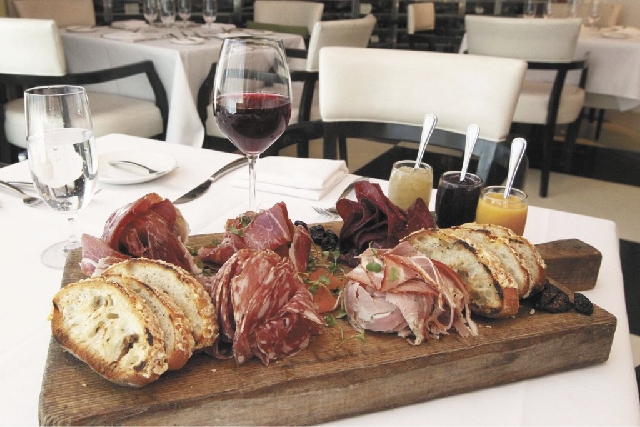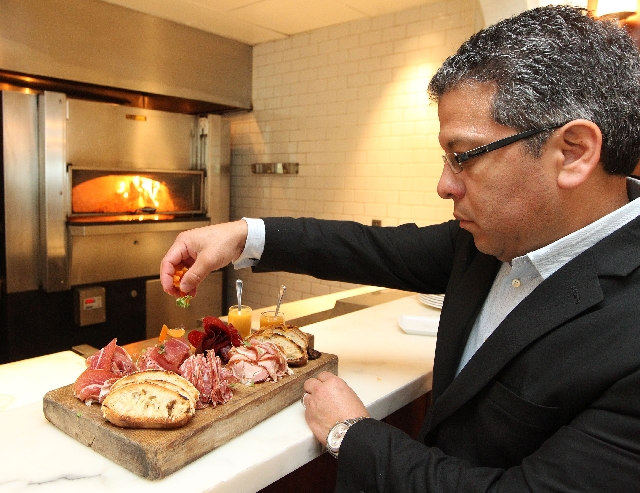Charcuterie lets meat get the party started
Charcuterie is popping up more and more on local restaurant menus, but here’s something you may not have thought about: It’s great for entertaining at home.
“It’s something that inspires sharing and conversation and socializing,” said Rory Herrmann, executive chef at Bouchon Bistro at The Venetian. “People tend to keep going back to it. You can leave it there and it doesn’t diminish.”
And here’s another great thing about it: The flexible nature of charcuterie means it can be molded to fit nearly any situation.
First, what is it? Charcuterie is, simply, a selection of prepared meats, usually attractively displayed and nearly always shared.
But, you say, you don’t have a charcuterie board. No problem.
“Usually, what I would say is use whatever you have and would want to showcase,” said Bob Howald, co-owner of Valley Cheese & Wine on Horizon Ridge Parkway in Henderson. “Wooden boards, or ceramic trays, which are a little bit easier to clean up. And people have ceramic trays in their house.”
Then you choose your meats. Howald recommends three or five but always an odd number, because “it just looks better.” Herrmann likes to use four kinds, and Matthew Silverman, executive chef at the Vintner Grill on Charleston Boulevard, is in the three-to-five camp.
The most important thing, all of them said, is variety in flavor and texture.
“A salami or two,” Howald said. “If two, one that has a stronger flavor, like a Finocchiona (which is flavored with fennel) or something spicy, and something like a Tuscan or Genoa, something a little more traditional and very approachable. You could also do something like a Spanish chorizo.”
He also likes to add a nonpork product, perhaps a bresaola, which is air-dried beef, or a duck prosciutto or duck salami.
And Howald noted there is a practical reason for not going beyond five items.
“Whoever makes up the tray or is presenting the tray, people are going to be asking about it,” he said. “It’s easier to remember three or five things.”
Herrmann said to bear in mind what you and your guests like to eat, and consider some taste-testing.
“That’s the great thing about charcuterie,” he said. “There are so many different forms of pates and sausages and meats. Go to the market and really taste and find out what you would like on that plate, platter or board.”
Herrmann, too, likes contrast, such as using finely and coarsely ground sausages.
“Don’t forget your pates,” he said, “like your country pate or foie gras terrine or something to put it on there and break it up. Again, for texture, flavor and animal.”
“Use different flavor profiles,” Silverman said. “Sausages to whole legs — like prosciutto — that are cured. Also smoked. But I don’t like to put too many smoked items on the same tray.”
A Silverman favorite: mortadella, which is a soft, almost creamy sausage.
“It’s different than a hard-cured salami, which is dry,” he said. “I like to play with textures and flavors.”
But wait! There’s more. Even in charcuterie, man and woman don’t live by meat alone. All three chefs said they recommend bread instead of crackers, usually something like a baguette, which may or may not be toasted or grilled.
Silverman likes to make his own mustards, flavored with things such as dried apricot or tarragon, which complement the flavors in the meat. While he’ll sometimes serve his charcuterie with pickled vegetables, he often uses dried fruit.
“With dried chorizo or some spicy stuff, that adds a little sweet with it,” he said.
Howald and Herrmann prefer the vegetables.
“Olives, cornichons — anything pickled,” Howald said. “Pickled onions. And whole-grain or hearty mustard.” Maybe some almonds.
Herrmann said to consider some of the spring vegetables that are in the market now — haricots verts, small peppers — and pickling them yourself.
“Or you can go to the market and buy those beautiful pickled vegetables,” he said. “I think that acidity kind of cuts the fat. And the last thing, a good Dijon mustard.”
So how much should you figure per person? That depends on what you’re planning, because that’s another flexible aspect of charcuterie.
“People make complete meals out of it, people use it as a starter or just something to put out to go with other appetizers or on a buffet,” he said. “Having that kind of shared, fun food is nostalgic.”
Howald said if the charcuterie is going to be part of a bigger selection of foods, 1 ounce — total — per person is enough. If the charcuterie is the main event, he suggests a total of 3 ounces of meat per person; Herrmann suggests 3 to 4 ounces total for the larger amount.
If you’re having a party, Howald suggests staging several trays around the room.
“Otherwise,” he said, ”you get that bottleneck jam-up. Two or three spaced around the room promotes more mingling and flow. If it’s a big party, I suggest that the trays are the same, so somebody’s not trying to hit every tray.”
Herrmann said the important thing is not to skimp.
“It’s one of those things that’s generous and abundant,” he said. “You really want to make sure there’s enough for people to pick at.
“And having a little bit extra never hurts. You’ve got stuff for sandwiches the next day — especially if you’ve got that great bread and that mustard.”
Contact reporter Heidi Knapp Rinella at
hrinella@reviewjournal.com or 702-383-0474.























